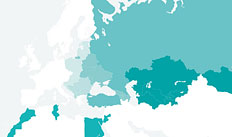Chapter 3
Box 3.3 Using prudential tools to stem the credit boom in emerging Europe, 2004-08
Towards the mid-2000s several countries in the CEB and SEE regions began to experience credit booms driven by capital inflows stemming from ample global liquidity and the expectation of rapid income convergence with western Europe. Given their open capital accounts, countries that had opted for a fixed exchange rate regime had only one means of restraining these inflows – to experiment with various macro-prudential policies and lending restrictions applicable to the banking system as a whole.
This box considers the experience of three countries – Bulgaria, Croatia and Latvia – which attempted such restrictions to varying degrees. The main conclusion is that while the measures appear to have had some effect – at least in Bulgaria and Croatia, where they were applied early and with greater determination – they were quickly circumvented through direct lending from parent banks and through the increased activity of non-bank entities, such as leasing companies.24 This undermined prudential policies by leaving local subsidiaries with poorer quality borrowers, and shifting credit creation to less regulated parts of the financial sector. Differences in objectives and poor coordination between host and home-country supervisors played a key role in explaining these failures.
Source: IMF IFS and IMF papers cited.
- Croatia implemented one of the most assertive prudential policies during the credit boom. From 2004 onwards the country gradually and successively implemented higher reserve requirements for credit growth above certain thresholds. The authorities also applied additional capital charges for market risks, unhedged foreign currency exposure or loan growth above certain thresholds, and intensified efforts to coordinate cross-border supervision. However, some of these measures, such as reserve requirements applying to banks' foreign borrowing, effectively amounted to a capital account restriction and were subsequently dropped in the run-up to Croatia's EU accession. It is noteworthy that credit growth in Croatia never became excessive, and that additional measures introduced in early 2007 contributed to a further slow-down (see Chart 3.3.1). However, quantitative limits on credit growth likely came at a cost, by disproportionately affecting small and medium-sized enterprises (which are more prone to rationing by banks), impeding competition within the banking system and leading to disintermediation towards cross-border lending and non-bank institutions, which are harder or impossible to supervise.
- Bulgaria implemented the highest minimum capital adequacy ratio of all new EU member states throughout the credit boom. The country nevertheless registered credit growth of almost 50 per cent in 2004. Liquidity measures taken in the early years of the boom (2004-05), such as reserve requirements and withdrawal of public deposits, were quickly deemed insufficient. The central bank then switched to more direct administrative limits on the expansion of credit in each institution (for example, punitive marginal reserve requirements on credit growth above a certain uniform permissible quarterly expansion). While there was some initial impact, banks quickly adapted by selling loans to parent banks and to affiliated non-bank entities within Bulgaria. After a brief drop in credit growth in 2006, private lending again accelerated to growth rates above 50 per cent.25
- Latvia experienced the most rapid boom in private sector credit of all three Baltic economies, fuelled by low financing costs within a fixed exchange rate regime, overly lax fiscal policy and expectations of rapidly rising incomes following EU accession in 2004. Institutional underdevelopment (for example, the absence of a comprehensive credit register) also contributed to the excessive boom, which only ended when the banks tightened credit in reaction to concerns by the Swedish supervisors in the summer of 2007. The Latvian authorities had been slow in utilising the few prudential tools at their disposal (such as tighter property valuation standards).26 The Swedish authorities – supervising the key Swedish parent banks that control about 60 per cent of the Latvian banking market – were also slow to act. Even though the Swedish Riksbank flagged growing risks as early as 2005, the Swedish financial supervisor resisted raising capital adequacy standards.27 What was perceived as poor coordination between the various supervisory bodies motivated the establishment of the Nordic-Baltic Memorandum of Understanding that was signed in 2010 (see Box 3.5).
24 See Bakker and Gulde (2010).
25 See IMF (2007).
26 See Purfield and Rosenberg (2010).
27 "The crisis in the Baltic – the Riksbank's measures, assessments and lessons learned", speech by Governor Stefan Ingves (2 February 2010), available on the internet at: www.riksbank.se/en/Press-and-published/Speeches/2010/Ingves-The-crisis-in-the-Baltic--the-Riksbanks-measures-assessments-and-lessons-learned-/.







